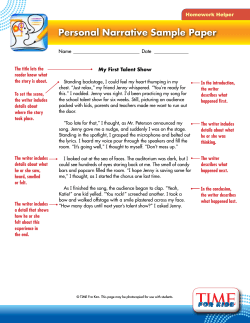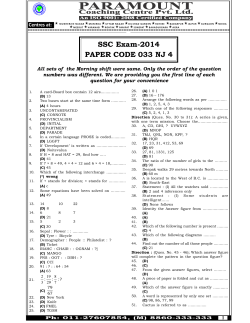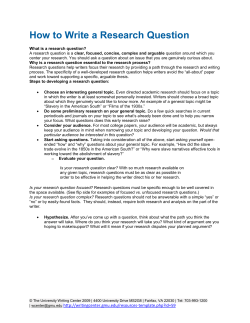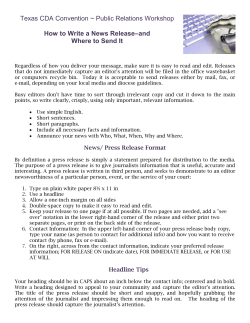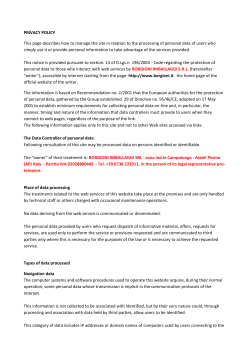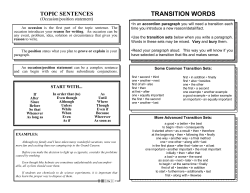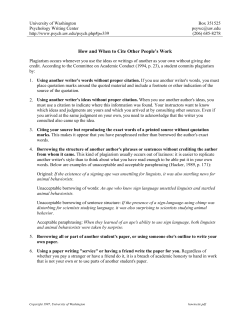
Close Reading – The More Difficult Questions (and how to... A. Linking Questions
Close Reading – The More Difficult Questions (and how to answer them) A. Linking Questions This question is designed to assess your understanding of how writers link similar or opposing points together in a way that helps the flow of their argument. The question might ask you to show how a sentence provides an effective link between two paragraphs or ideas. How to answer: 1. Identify and write down the link word and explain that it shows a change in direction of the writer‟s argument 2. Quote the part of the sentence which refers back to the earlier topic 3. Explain, in your own words, what the earlier topic is 4. Quote the part of the link sentence which looks forward to the next topic 5. Explain, in your own words, what that new topic is Example: How does the writer establish the link between Paragraph 4 and Paragraph 5? If you really needed to spend money, you could still get passport photos from the curtained booth, business cards from the autoprinter, donate to city hospitals by dropping money into a Howitzer shell, or Test Your Emotional Temperature on The Passion Chart, if you were prepared to squeeze a couple of handlebars. Nothing else to do but look at the clock, the Arrivals and Departures board – on which nothing was imminent – and the people. Apart from a bag lady who was curled round one of the ring seats like a seal, asleep – or trying to be – the only people using the seats were a young couple. Japanese perhaps… 1) The expression ”Apart from“ is a linking phrase that indicates a change in direction for the author‟s argument. 2) “The bag lady” refers back to the previous paragraph 3) Which talks about how there is nothing to do at the train station other than look at the boards and the people that are around about. 4) “The only people using the seats” furthers the writer‟s new topic 5) Which is to explain who the other people are that are round about him and are interesting enough to comment upon. Now Try Yourself: Explain how the one sentence paragraph is an effective link between paragraphs 8 and 10. Howard could see he knew the berries weren‟t ready yet, like the ones behind the steading that they always picked; and he understood that this was a lesson being set up for him when he came home without brambles: not to tell lies. And there‟d be another lesson behind this one, the real lesson: that is father had been right about that sort of new fangled nonsense coming to grief. In spite of this, he forgot it all and slipped through the Racecourse fence. A crowd mobbed around the grandstand where they served drinks and sandwiches. He made his way through the high society of Lanark, dolled up to the nines… B. Context Questions For this type of question you are usually asked to use the context to explain the meaning of a particular word. In other words, how do the words round about help you to understand what the highlighted word means? How to answer: 1. First of all, find the word in the passage that you have been directed to and read that paragraph again. 2. Consider whether you understand the meaning of the word. If so, great. If not, look at the surrounding words and try to work it out. 3. Once you have worked out the meaning, then you should look at the context surrounding the word in question and pick out the words which have led you to your decision about its meaning. You must do this even if you knew what the word meant anyway. 4. Then in your answer you should give the DEFINITION of the word and QUOTE the words from the context EXPLAINING why they led you to your answer. Example Explain how the context helps you to understand the meaning of “vicarious” Paragraph 3 and 4: “At first I was angry at him, frightened for him, but now suddenly I get this rush of joy, watching him race out there into the cold level space of the stilled river, free and warm and vivacious in that smoothed and frozen silence. I think he‟s done it, I think he‟s across the river and safe and there‟s a buzzy glow of vicarious accomplishment starting to well up within me, but then there‟s a cracking noise and he falls…” 1. Do I know what it means? If yes, fine. If not, then look to the context. The word “accomplishment” is right next to the word “vicarious” which tells us that something has been achieved. The fact that the narrator is watching his friend and that he says “I think he‟s done it” shows us that the achievement is his friend‟s. What does this tell us when we put all of this information together? 2. “Vicarious” must mean that the narrator is experiencing this achievement through his friend. So, generally, “vicarious” means to experience something through someone else. 3. Remember that in your answer you must give the meaning and quote the words from the context which helped you to understand –even if you knew the meaning of the word anyway. Answer: The word “vicarious” means to experience something through another person. The word “accomplished” shows that something has been achieved and the fact that the writer says, “I think he‟s done it” shows the reader that it is through another person that he is experiencing this incident. Now Try Yourself: 1. Explain how the context helps you to understand the meaning of “taxidermy” in Paragraph 10. “When the London dodo died, the animal was stuffed and sold to the Ashmolean Museum in Oxford. Taxidermy not being what it is today, over the next few decades the dodo slowly rotted until it was thrown out in 1755. All, that is, except the moth-eaten head and one leg” 2. “…the quick adhesive of filial tolerance.” (Paragraph 14) How does the context help you to understand the meaning of this expression? “They got on well. They never had any difficulty talking. There were never any silences. They tore their parents to bits and put the bits together again with the quick adhesive of filial tolerance. They were two earnest adolescents, able to vary their solemn dialogue with a private joke…” 3. Give the meaning of “interred” and show how the context helped you arrive at that meaning. The building nowadays known as Maes Howe is a Neolithic chambered cairn, a tomb where, 500 years ago, they interred the bones of the dead. C. Word-choice For this type of question you are usually asked to think about why a particular word or expression is appropriate. This just means that you are being asked to think about why the author chose that particular word or expression when they have so many to choose from. What makes this a good word to have chosen? How to Answer: 1. First of all find the word in the passage that you have been directed to and read that paragraph again. 2. Consider whether you understand the meaning of the word. If so, great! If not, look at the surrounding words and try to work it out. 3. Think about why the author chose that word in particular when they could have chosen another. Is it appropriate because it is particularly relevant to what the passage is about? Does it help to create a particular atmosphere? Is it frightening or funny perhaps? Does it give you a clear picture of what the writer is trying to describe? If so, make sure you explain what that picture is. Example: “…his moustache bristling over the paper.” Why is bristling a particularly appropriate word to use in this context? “ „They‟re asking for trouble,‟ his father said, his big legs folded at the table, the tackets in his boots squealing shortly when he moved – ready to stride out if anything was wrong – his moustache bristling over the paper. „They‟ll catch it,‟ he‟d add. In the early days of aviation his father detested its uselessness and looked for the flyers to get their comeuppance.” 1.Do I know what it means? Yes, a bristle is a short, coarse hair like you would find in a sweeping brush. It is also used to convey anger or to suggest that someone is offended if they are said to be „bristling‟. 2. Why is it a good word to use here? The writer tells us that his moustache is „bristling‟ over the paper, so there is a literal connection with hair and he is also angry at the aviators. Answer: The word „bristling‟ is literally connected to the idea of the hair of the man‟s moustache, but he is also angry with the aviators and so the word „bristling‟ is used figuratively here to show how much he despises them. Further Example Why do you think the writer has chosen the word “flooded” to describe how his memories returned? “Childhood memories of underwater programmes on TV flooded in, mixing with books and magazines on sharks and the film cartoon of Marine Boy. Once I had gained some confidence, Stuart returned to the surface to collect underwater photographer Gavin Anderson. ….” 1. Do I know what it means? Yes it is when lots of water pours into something, usually very quickly. 2. Why is it a good word to use here? The passage is about a man surrounded by water as he swims with sharks. Flooded suggests lots of water moving quickly, but he is talking about memories, so what is the connection? The idea is of lots of memories and the speed of the memories returning. Answer: He is suggesting that the memories come back very quickly and that there are lots of them. It‟s also a good word to use as the passage is about water. Now Try Yourself: 1. Explain fully what the writer suggests by using the word “flickering” when describing the candle. “The door creaked open. A draught of cold air blew up from the stairs to the dark crypt and the hairs on our arms stood on end. The faint light from the flickering candle disappeared, there was a muffled scream, a sound of running footsteps and then some raised voices.” 2. “ „Ice,‟ said the stranger, as though he had not heard her, „I‟ll never be warm again.‟ His voice cracked and she realised that his shoulders were heaving. „Oh, the ice,‟ he repeated. He held his hands before his face. He wrapped his fingers together, and his whole body seemed to be fighting to suppress a succession of spasms. „You can come back tomorrow,‟ said Pelagia, appalled by this gibbering apparition, and completely at a loss. „No crampons, you see. The snow is whipped away by the wind, and the ice is in ridges, sharper than knives, and when you fall you are cut.‟” D Sentence Structure Some questions will ask you to look at the writer‟s sentence structure and to comment on the effect that the writer is trying to create. 1) Look at the length of the sentence. Has the writer used a long or a short sentence and what is the effect? Is it a very long sentence to show a list of something? Or is it to show lots of ideas jumbling around in someone‟s head? To show confusion? Is it a very short sentence to show that someone is angry or that something has happened suddenly? Or to emphasise an idea, to make it stand out? (Remember to say why the writer would want it to stand out). Is it even a sentence? Remember that a sentence should make complete sense on its own, and it must contain a verb. Why would the writer use a non-sentence? Is it to show shock or surprise? 2) Look at the punctuation of the sentence. Is there any particular punctuation mark on which you could comment, for example, colon, semi-colon, comma, brackets etc? Do you have lots of commas which create a list? Do you have brackets so that the writer can make a comment, perhaps for humour or for criticism? 3) Look at the function of the sentence (what kind of sentence you are dealing with). A statement – indicated by a full stop. An exclamation – indicated by an exclamation mark. A command – indicated by a full stop or an exclamation mark. A question / rhetorical question– indicated by a question mark. 4) Look to see if there is any repetition in the sentence (or in more than one sentence) in the paragraph. You should look to see if there is anything unusual about the sentence structure and then make a comment on why you think the writer has done this. Remember that this is a just a guide and you will have to read the question very carefully to see exactly what the question is asking you to do. Example: Question 1a) and 1b) “Strathspeld is everywhere white.” a) What is unusual about the structure of this opening part of the sentence? b) What effect does this create? Looking at this sentence you can see that it the word order is unusual. We would not expect the place name to come first here. We would expect this to read, “Everywhere is white in Strathspeld” or perhaps “White is everywhere in Strathspeld”. So, we know that the word order is inverted, but what it the effect of this? Because the word order is unusual, the writer is clearly trying to emphasise one or more of the words. Here, he is emphasising the words, “White” or “everywhere” to give the impression of the blanket coverage of the snow. Sample answer: a) The word order is inverted as we would not expect the sentence to read with the place name first. b) It emphasises the words “white” and “everywhere” to show just how much snow had fallen. Now Try Yourself 1. “Pelagia was astounded.” How does the sentence structure in the rest of this paragraph develop Pelagia‟s sense of astonishment? “Pelgia was astounded. Psipsina was afraid of strangers, and how did this ghastly ruin know her name? Who could have told him? She wiped her hands on her apron for the lack of any sense of what to think or do, and said, „Mandras?‟” 2. “The road…tapered to infinity…” Explain how the STRUCTURE of the second sentence in Paragraph 3 helps to make the meaning of this expression clear. “The road ahead tapered to infinity, in stages. Hill led to hill led to hill, and at each summit the road abruptly shrank to half its width, then half its width again, until it became a hairline crack in the land, then a faint wobble in the haze, then nothing.”
© Copyright 2025

